Eugène Burnand (1850-1921)
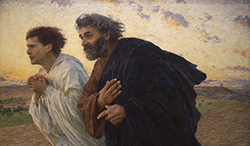
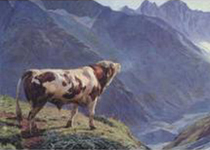 Home page
Home page
Biographic information
A full list of his works can be seen on Wikipedia
He was born Charles Louis Eugène Burnand on 30th August 1850 in the chateau de Billens, Moudon, Vaud, Switzerland (in the French speaking region). His father, a forestry inspector, was Edouard Burnand (b. 1814) and his mother was Henriette Louise Burnand, (née Foltz b.1821). He was the youngest of three brothers in a bourgeois protestant family that was long established in Moudon, many members of which were, and had been, part of the civic establishment of the town. His two brothers were grown up and working in France.
The family moved temporarily to Florence in 1860 and on their return the following year to Schaffhaussen (in northern Switzerland) Eugène studied at the local secondary college where the language was German. On leaving school, where he did well, on the advice of his father, who was a keen amateur painter, he enrolled in a Zurich technical college to study architecture in 1867. His father was well aware of the difficulties of making a living as an artist and he insisted his son acquired a way of earning a living reliably. He was able to abandon architecture after getting his diploma in 1871 having realised his talents and interests were truly for art. The same year he started to study art in Geneva under the famous artist Barthélemy Menn, and a few months later he went to Paris and found himself in a talented circle of young Swiss and French artists where he ardently pursued his studies under Jean-Leon Gérôme. Subsequent years were spent painting, travelling and studying, mainly in different regions of France, particularly Provence, where he had relatives and friends.
Versailles was a centre for artists, and he was a friend of the Girardet family in Versailles, well known painters and engravers who were also from the same area of Switzerland. In 1878 he married Julia Girardet whom he had first met seven years previously, and lived in the Girardet family home in Versailles initially, and later moved to an appartment nearby, until they moved to Paris in 1885. He learnt engraving from Paul Girardet, his father-in-law. He was already selling illustrations to important publishers at this time, and he produced one of his best known large canvases ( 1879, 3 x 2 metres), 'La Pompe à Feu (The Fire Pump)'. 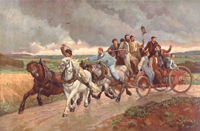 A child, André was born in 1879 but died aged 18 months. A second son Franz was born in 1880, and they went on to have five more sons (including a set of twins) and twin girls in 1893, all of whom went on to successful and sometimes distinguished lives.
A child, André was born in 1879 but died aged 18 months. A second son Franz was born in 1880, and they went on to have five more sons (including a set of twins) and twin girls in 1893, all of whom went on to successful and sometimes distinguished lives.
He took another step to fame in 1880 by providing illustrations for a new edition of the famous contemporary epic poem 'Mireille', by the Provençal poet Frédéric Mistral, written in Occitane, the old language of that region. He became a lifelong friend of Mistral and was to name one of his twin daughters Mireille. 1883 saw him commissioned to do watercolours for a special set of novels by Alphonse Daudet for an American client. His Bull in the Alps picture (top right) was completed in 2 months of 1884 near Arolla in the Herens Valley, Valais, Switzerland. This became his signature picture and demonstrated his mastery of animal painting and understanding of the importance of animals in Swiss rural life. 1885 saw him receive his first commission for a portrait and he moved with his family from Versailles to Paris. He was kept busy working on illustrations for numerous publications and was on more large works of his own such as La Faucheur 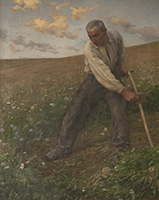 and Le Semeur. In 1889 he presided over the Swiss fine arts commission for their contribution to the Universal Exhibition of Fine Arts in Paris, where he also received a gold medal (1st class). He spent the winter of 1890/91 at the family chateau at Seppey, near Moudon, Switzerland, where he worked on Dans les Haut Patûrages for Nestlé, a picture that was widely used in their advertising.
and Le Semeur. In 1889 he presided over the Swiss fine arts commission for their contribution to the Universal Exhibition of Fine Arts in Paris, where he also received a gold medal (1st class). He spent the winter of 1890/91 at the family chateau at Seppey, near Moudon, Switzerland, where he worked on Dans les Haut Patûrages for Nestlé, a picture that was widely used in their advertising.
He became a Chevalier of the French Legion of honour in 1893, and in 1895, after living near Seppey to look after his sick parents, he moved, after they died, to a farmstead property in Fontfroide-le-Haut near Montpellier with his family of eight children. This had been put at his disposal by a cousin, Henry Leenhardt. He made the move after the completion of a major historical work La Fuite de Charles le Téméraire. 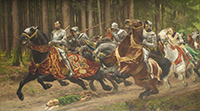 It was during his time in Montpellier that he became seriously focused on religious art.
It was during his time in Montpellier that he became seriously focused on religious art.
1898 saw the completion of his now best known work The Disciples (top left on this page). It was bought by the French State for the Luxembourg Museum in Paris, and is now in the Musée d'Orsay, Paris. Another work that can be seen in Paris is a picture of Mont Blanc, done in 1900, for the Train Bleu Restaurant at the Paris Gare de Lyon. This is still one of the best restaurants in Paris and his ceiling panel of Mont Blanc is one of many decorations by famous artist who were commissioned for the restaurant project.
He made a trip to London in 1901 to arrange an exhibition of his latest work The Sacerdotal (High Priestly) Prayer,  and on his way back to Montpellier he met up with publishers and laid the ground for the Les Paraboles (The Parables) project. He spent four productive years on the Parables pictures, working from a new domicile in Hauterive near Neuchatel, and the The Sacerdotal Prayer which he worked on in a six month stay in Florence. It was bought for the Lausanne Museum and La Ferme was bought by the Vaud Canton. He became somewhat unpopular with his Swiss contemporaries, notably Ferdinand Hodler, for his reactionary and moralistic views. A new work, La Voie douloureuse (Via Dolorosa),
and on his way back to Montpellier he met up with publishers and laid the ground for the Les Paraboles (The Parables) project. He spent four productive years on the Parables pictures, working from a new domicile in Hauterive near Neuchatel, and the The Sacerdotal Prayer which he worked on in a six month stay in Florence. It was bought for the Lausanne Museum and La Ferme was bought by the Vaud Canton. He became somewhat unpopular with his Swiss contemporaries, notably Ferdinand Hodler, for his reactionary and moralistic views. A new work, La Voie douloureuse (Via Dolorosa), 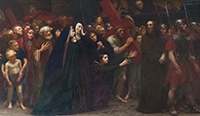 gained a mixed reception. He moved to Paris in 1907 and remained until 1914.
gained a mixed reception. He moved to Paris in 1907 and remained until 1914.
The first Burnand illustrated edition of Les Paraboles was published in 1908 by Berger-Levrault. In 1909 he designed the 500 and 1000 franc notes for the Swiss Bank. Illustrations for a book about St Francis of Assisi in 1913 brought more acclaim. 1914 saw him and the family return to Seppey for the duration of the war. One son was mobilised in the French army and four others in the Swiss military. Busy with many projects until this time, he now started work on on a massive painting, Labour dans le Jurat  in May 1915 which was finished in October. The next January it was destroyed by fire near Lausanne. He did it again and the second version was finished in October 1916. This period of his life also involved organising conferences on "religion and art".
in May 1915 which was finished in October. The next January it was destroyed by fire near Lausanne. He did it again and the second version was finished in October 1916. This period of his life also involved organising conferences on "religion and art".
He had also been doing portraits for a series he called 'Types Vaudois', the local characters who where typical of the rural environment in Vaud that gave him a deep sense of 'home'. He did not feel however, that this was a powerful theme for his portraiture. This thematic drive soon focussed on a new subject that became his obsession for the next few years. This exciting project was series of portraits called Les Allies dans La Guerre des Nations (The Allies in the War of Nations). By 1920 he had completed 104 pastel portraits in Paris, Marseille and Montpellier where he found the variety of subjects he needed. The portaits are the main feature of this site.
In 1917 he produced a postcard for a national celebration of the Red Cross, a Swiss organisation originally, that was awarded the Nobel Peace Prize that same year. Half a million copies were sold in a few days, profits going to the Red Cross. 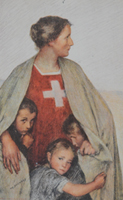
After the armistice had been signed, ending the war, he returned with his family to the same Paris residence they had left 4 years previously. Tragedy struck in the form of influenza that November. It killed son Daniel (also an artist) and laid the artist low. (The epidemic of Spanish 'Flu at that time killed more than the war had). He was was made an Officer of the Legion of Honour in 1920 shortly after a fire had damaged his workshop and several paintings. Seemingly having suffered small heart attacks around this time, he developed pneumonia in February 1921. Attended by his son Rene, a doctor, he died on February 4th in his Parisian home. Four weeks later his wife Julia died too. They are buried at the small church at Vulliens, just a few kilometers from Seppey, which is in that parish.

Much of this information is taken from "Eugène Burnand, peintre naturaliste" by Philippe Kaenel (Professor of Art History at Lausanne University) ISBN:88-7439-104-8, and "Eugène Burnand, the man, the artist and his work" by René Burnand. Pub. Berger-Levrault, Paris 1926.
Seppey, near Vulliens is subject to spelling variation that causes much confusion. Séppey is one, Sépey is another. The main point is that it is that the address is Seppey, Vulliens, Vaud (GPS North 46.635699 East 6.794256). On no account should it be confused with Le Sépey, a ski village 50 or so miles away!